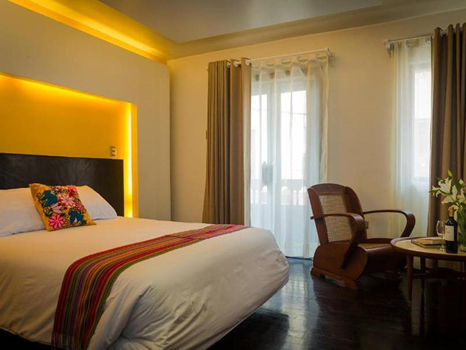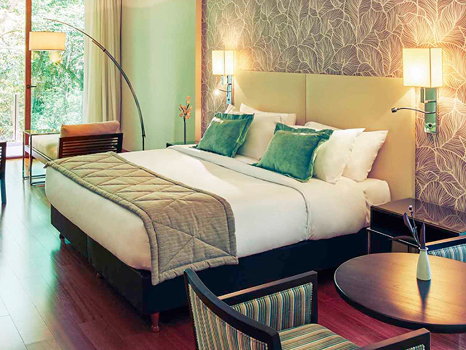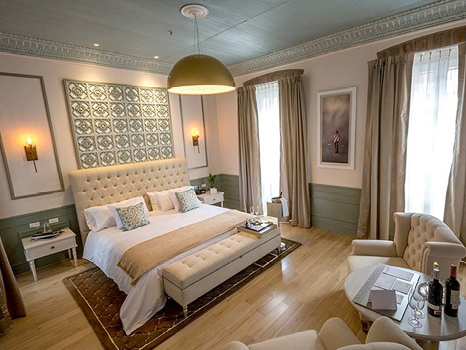Galapagos South Western Islands Cruise A | Archipel I
8 Days
From NZD 9,363
STYLE: Small Ship Expedition Cruise
Trip Code: ECACA8A
DIFFICULTY RATING: 2 (light adventure)
Start: Galapagos Islands, Ecuador
Finish: Galapagos Islands, Ecuador
SHIP: Archipel Catamaran
 Destination
Destination
Ecuador, Galapagos Islands, South America
 Departure Date
Departure Date
Select Mondays
 Meals
Meals
All Meals, Water, Tea & Coffee While Onboard Your Galapagos Cruise
 Transport
Transport
Group Transfers In The Galapagos To & From Your Vessel
 Accommodation
Accommodation
Cabin onboard a ship
Enquire Now


 Included Sightseeing
Included Sightseeing
Daily Excursions, Panga Rides, Shore Landings And Expert Briefings While Onboard
*Itinerary Is Subject To Change Depending On Weather Conditions And Government Regulations
OVERVIEW
Explore the wonders of the Galapagos Islands on this 8 day cruise itinerary onboard the Archipel I, that will allow you to discover the South and Western Islands, including Isabela, Fernandina, Santiago, San Cristobal and Santa Fe. Keep an eye out for colonies of blue and red footed boobies, the flightless cormorant and spot giant tortoises in the wild.
Check out the 5 Day Western Islands Cruise onboard the Archipel I
ITINERARY

AM - Arrival at San Cristobal airport.
Upon arrival at San Cristobal airport, you will pass through an airport inspection point to insure that no foreign plants or animals are introduced to the islands. A guide will meet you, help you collect your luggage, and escort you on a short bus ride to the harbour.
PM - Interpretation Centre and Frigatebird Hill (San Cristobal)
The Interpretation Centre, just outside the provincial capital city of Puerto Baquerizo Moreno, gives a perfect explanation of this unique archipelago. Its attractive exhibition is quite complete and helps you to get a clear overview and learn what makes this archipelago so unique. Information panels (in English and Spanish), pictures, documents, maquettes, and true-to-life dioramas tell various background and conservation stories about the islands in a different way.
A short, though often hot, uphill trail with steps, leads from the Interpretation Centre to the summit of Frigatebird Hill. Four panoramic viewpoints show Puerto Baquerizo Moreno from above, as well as the bays on both sides of the headland. On clear days even the distant, offshore sculpture of Kicker Rock can be seen! These wooded hilltops are one of the rare places where some magnificent and great frigatebirds form a mixed breeding colony.

AM - Santa Fe
Located in the southeastern part of the Galapagos, this island was formed from an uplift instead of a volcanic origin, which is why it is mostly flat. Some theories assure this could be the oldest island in the archipelago. Santa Fe is the home of several endemic species like the Galapagos hawk, Galapagos snake, Galapagos mockingbird, rice rats and one of the two species of land iguanas of the islands. After disembarking in the beautiful and clear waters, you will be in contact with one of the many sea lion colonies. Along the trail, many salt bushes can be seen as well as giant prickly pear cactus, gigantism is a characteristic of oceanic islands.
PM - South Plaza
South Plaza is located to the east of Santa Cruz Island, and forms part of a pair of islands known as “Islas Plazas”. Despite its small size, some of the most interesting and outstanding species of the Galapagos are found here. The Plazas land iguanas are smaller than their relatives found on other islands. There are several hybrid iguanas throughout the island; a result of crossing a marine iguana with a land iguana. They are unique and recognizable at first glance by their black/grey colour, with a land iguana’s crest, but the face and tail of the marine iguana. The big population of iguanas is due to the presence of prickly pears, their favourite food. Swallow-tailed gulls nesting in the rugged cliffs are seen along with other sea birds as Audubon shearwaters, red-billed tropicbirds, frigate birds and brown pelicans.

AM - North Seymour Seymour is an uplifted (as opposed to volcanic) island and therefore is generally flat and strewn with boulders. There are good nesting sites here for a large population of magnificent frigate birds. Blue-footed boobies perform their courtship dance in the more open areas and swallow-tailed gulls perch on the cliff edges. Despite the tremendous surf that can pound the outer shore, sea lions haul out onto the beach and can be found bodysurfing.
PM - Chinese Hat is a 52 m/170 ft high volcanic cone, forming another islet right off the rocky coast of Santiago, where a small colony of Galapagos penguins have settled. Approaching Chinese Hat from the north, you will understand the meaning of the name. This is an excellent place to learn more about volcanoes, lava bombs and lava tunnels. You will arrive just in time to witness how this barren islet is colonised by pioneer species that have begun to sprout! Beautiful beaches of white coral sand and holes in the eroding lava fields are filled up with lava sand, which enables rooting. Galapagos sea lions and countless marine iguanas contribute to fertilisation and thus create many favourable options for newcomers, such as saltbush and the sesuvium carpet.

AM - Twin Craters and El Chato Reserve (Santa Cruz)
The native scalesia forest of El Chato Tortoise Reserve is the best place to search for Galapagos giant tortoises in their most authentic setting! Despite the interesting breeding centres – where you are guaranteed to find tortoises in their corrals – there is nothing better than to observe them in their wild environment. Though it can be quite moist and muddy, your visit may turn into an adventurous quest when they have left their favorite pond silently.
The Twin Craters are found on either side of the road leading to Puerto Ayora. These impressive formations are not really volcanic craters and were formed by magma domes, which hardened on the outside while the lava continued flowing inside, leaving huge and empty magma chambers that eventually collapsed, leaving two large holes. The craters lie within a lush scalesia cloud forest, a high-altitude plant species that are endemic to the Galapagos. This area is also home to the carpenter finch, which uses tools to search for food. There may also be opportunities to see the vermillion flycatcher, a small red-breasted bird.
PM - Fausto Llerena Breeding Centre (Santa Cruz)
At this site, you can observe tortoises that come from various islands of the archipelago. They comply with the captive breeding programme and then return to repopulate the areas where their population has been affected. The land iguanas of Santa Cruz, Isabela and North Seymour are also in a captive breeding programme, as the populations in these areas suffered from feral dogs.
One of the main attractions is the famous embalmed Lonesome George. Estimated to have died between 93 and 109 years of age, it is recognised as the last of its kind and a symbol of the efforts invested to conserve endangered species. The captive tortoises are used to the presence of visitors, so it's a great place to take photos with them.

AM - Moreno Point (Isabela)
Moreno Point is located on the north coast of Isabela Island, between the volcanos Sierra Negra and Cerro Azul. The trail runs along a solidified pahoehoe lava flow into a complex of coastal lagoons. Its main attractions are several species of birds, which are found around the lakes and mangroves.
PM - Urbina Bay (Isabela)
Urbina Bay is located along the west coast of Isabela, between Elizabeth Bay and Tagus Cove. It is close to the base of the Alcedo Volcano. The coastline has undergone a major uplift in 1954, which caused the shore to expand three quar ters of a mile out. Here you will be able to find corals, shells, and many other calcareous organisms exposed above water. Urbina Bay is home to large and colorful land iguanas and giant tor toises of the Alcedo Volcano population. A lot of Darwin finches can be seen as well.

AM - Espinoza Point (Fernandina)
Fernandina is the third-largest island in the archipelago and has a single visitor site: Punta Espinoza, located at the northeastern tip of the island. Marine iguanas conglomerate in larger groups than on any other island. They bask around in the sand, swim near the shore and sometimes block the way at the landing dock. Among the unique species found here, is the flightless cormorant. This bird had to adjust its way of survival and perfection its skills of finding food in the ocean. Their wings, tails and feet progressively adapted for swimming. To see these birds is to witness evolution happening right in front of you.
PM - Vicente Roca Point (Isabela)
Whilst having lunch we will cross the Bolivar Channel for the last time to Vicente Roca Point, just at the mouth of Isabela’s seahorse-shape. While entering a dark cave below a spectacular arch, roaring echoes of the waves will accompany you. Just around the corner the collapsed amphitheatre of Volcan Ecuador offers another impressive view. The calmer waters of the coves are well-protected against the ocean swell and are a fairly cold, but great place for snorkelling amongst various species of shark, penguins, puffer fish and even seahorses!

AM - Egas Port (Santiago)
Puerto Egas is a black beach located on the west side of Santiago Island. Volcanic tuff deposits have favoured the formation of this special black sand beach and this is the main attraction of the Island. This site is called Puerto Egas because there was an attempt of Hector Egas to start the exploitation of salt, which failed. After all, the price of salt on the continent was very cheap and did not justify its exploitation in the Galapagos. The project was abandoned and they left their infrastructure.
PM - Rábida
Rábida Island is unique because of the red colour of the rocks and sand. The volcanic material in this island is very porous and external factors such as rain, saltwater and sea breeze have acted as an oxidizing agent. A short walk along a trail will lead you to a coastal lagoon behind the beach that allows for the observation of land birds as finches, doves, yellow warblers and mockingbirds. There is also a colony of flamingos at the lagoon.

AM - Black Turtle Cove (Santa Cruz)
After breakfast, you will check out and disembark the cruise for the last time at 08:30 am. Your last adventure is brief but enchanting, and will take place enroute to the airport. You will explore onboard the dinghy the green landscape of Black Turtle Cove, which is mostly composed of mangrove trees that host innumerable aerial and aquatic species. Observe how the quiet emerald lagoon and surrounding shallow bays enables the easy observation of sea turtles and as well as groups of sharks. The visit ends and you will disembark at 09:00 at Baltra island, ultimately reaching Baltra airport at 09:30, where its the official end of your cruise adventure.
WHY CHOOSE THIS CRUISE?
-
See a range of wildlife on this 8 day itinerary that discovers the beauty of the Western and Southern Islands, cruising on the well appointed Archipel I.
-
Spot stunning landscapes from volcanic craters to green and lush landscapes and enjoy snorkelling among a wide range of marine life, including white tipped reef sharks, rays and penguins.
-
Visit breeding programs that have helped endemic Galapagos giant tortoise species survive.

Archipel Catamaran
Embark on an exceptional Galapagos Island cruise aboard the Archipel catamaran. The ship offers comfortable accommodation for up to 16 passengers in 9 cabins, each featuring private bathrooms and captivating outside views. The catamaran also boasts amenities like a dining room, bar, lounge, library, TV, safety deposit box, and first aid for your convenience and entertainment. Marvel at the breathtaking scenery from the observation deck and spacious sundeck, complete with comfortable chairs for relaxation. Unforgettable adventures await!
Ice Class:
Length: 26.80 m
Breadth: 10.80 mMax
Draft: Cruising
Speed: 10 knots
Electricity: 110V / 220V Passenger
Capacity:16 pax
View Ship Details
Accommodation
We believe that appropriate accommodation should add to the authentic travel experience, as well as providing utmost enjoyment. For that reason our accommodation is scrutinised by our staff on the ground frequently, ensuring the properties adhere to our high standards. This key will help you understand the levels of accommodation available on this tour.

Standard
Comfortable properties with dependable facilities and service.

Superior
Comfortable properties with dependable facilities and service.

Deluxe
Luxurious properties with impeccable facilities and service.
Pricing per person & date
| Galapagos South Western Islands Cruise A | Archipel I from NZD 9,363 | ||
| Select Mondays | ||
EXTEND YOUR TRIP
Important Information
All entrance fees are subject to change without prior notice.
Please note kayak and water based activities are subject to weather conditions.
Prices are based on per person, twin share* (unless otherwise stated).
Prices are correct at time of publishing but are subject to change at any time.
*Itinerary is subject to change depending on weather conditions and government regulations.
Accommodation onboard the Archipel I
Transfers in the Galapagos and airport assistance
All meals whilst on-board including snacks
All shore excursions
Guiding and lectures by Galapagos Naturalist Guide
Snorkelling equipment (mask, snorkel & fins)
Use of kayaksExclusions
International flights
Return airfares from mainland Ecuador
Visa & reciprocity fees (if applicable)
Galapagos National Park Entrance Fee (US$ 200 per person subject to change)
Galapagos Transit Control Card (US$ 20 per person subject to change)
Travel insurance
Beverages other than tea & coffee
Personal expenses such as laundry & onboard communication
Gratuities for the crew
- 2 (light adventure)
Available upon request. Contact us for more details.
Departure date, currency fluctuation, seasonality & availability







